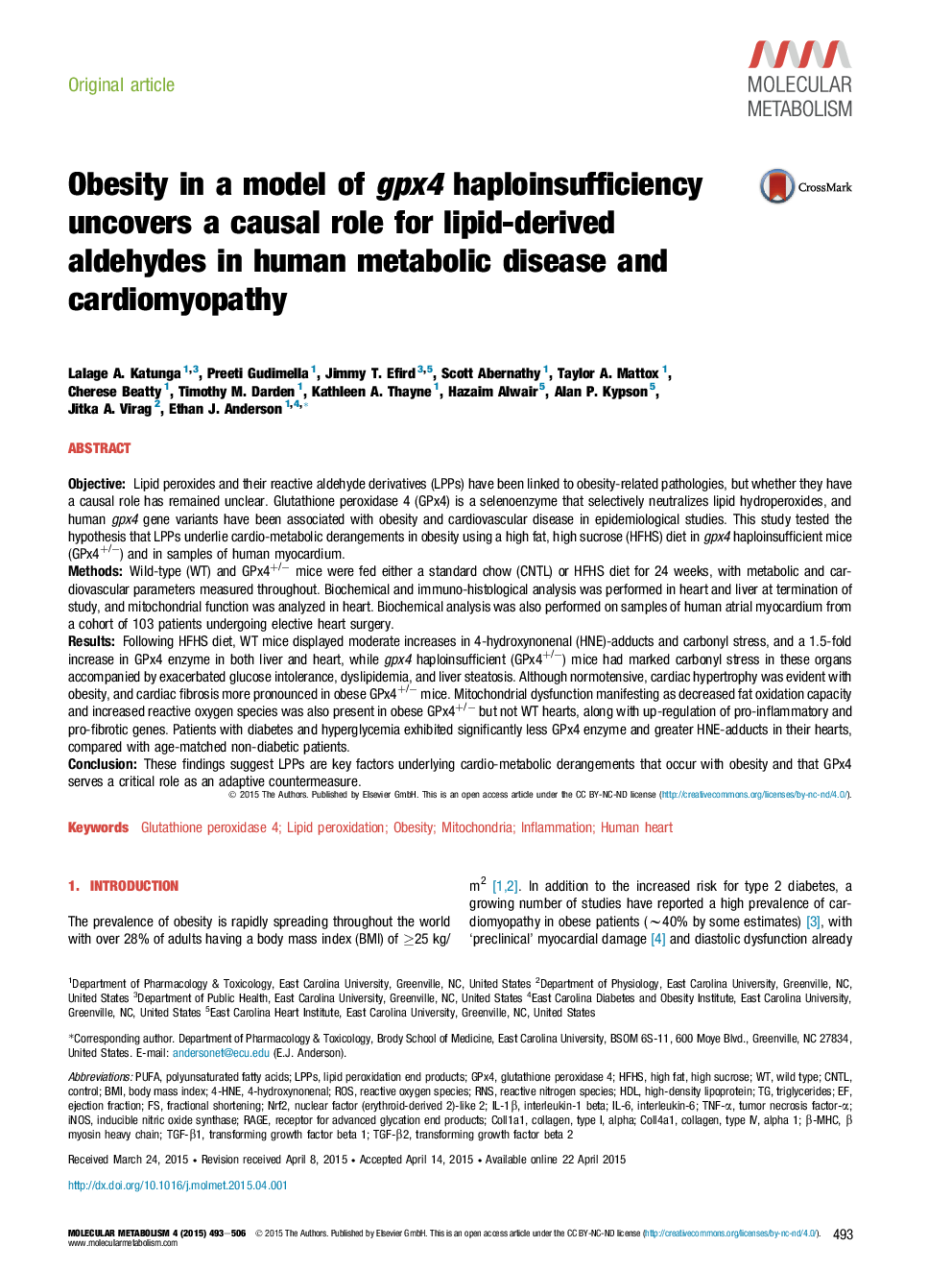| کد مقاله | کد نشریه | سال انتشار | مقاله انگلیسی | نسخه تمام متن |
|---|---|---|---|---|
| 3001310 | 1180583 | 2015 | 14 صفحه PDF | دانلود رایگان |

• Role of GPx4 and lipid-derived aldehydes (LPPs) in obesity was studied.
• Cardio-metabolic pathologies were exacerbated in GPx4+/− mice with obesity.
• Cardiac fibrosis and mitochondrial abnormalities more severe in obese GPx4+/−.
• Myocardium from diabetic patients exhibit less GPx4 and more LPPs than non-diabetic.
• An adaptive role for GPx4 to protect against LPPs in obesity is proposed.
ObjectiveLipid peroxides and their reactive aldehyde derivatives (LPPs) have been linked to obesity-related pathologies, but whether they have a causal role has remained unclear. Glutathione peroxidase 4 (GPx4) is a selenoenzyme that selectively neutralizes lipid hydroperoxides, and human gpx4 gene variants have been associated with obesity and cardiovascular disease in epidemiological studies. This study tested the hypothesis that LPPs underlie cardio-metabolic derangements in obesity using a high fat, high sucrose (HFHS) diet in gpx4 haploinsufficient mice (GPx4+/−) and in samples of human myocardium.MethodsWild-type (WT) and GPx4+/− mice were fed either a standard chow (CNTL) or HFHS diet for 24 weeks, with metabolic and cardiovascular parameters measured throughout. Biochemical and immuno-histological analysis was performed in heart and liver at termination of study, and mitochondrial function was analyzed in heart. Biochemical analysis was also performed on samples of human atrial myocardium from a cohort of 103 patients undergoing elective heart surgery.ResultsFollowing HFHS diet, WT mice displayed moderate increases in 4-hydroxynonenal (HNE)-adducts and carbonyl stress, and a 1.5-fold increase in GPx4 enzyme in both liver and heart, while gpx4 haploinsufficient (GPx4+/−) mice had marked carbonyl stress in these organs accompanied by exacerbated glucose intolerance, dyslipidemia, and liver steatosis. Although normotensive, cardiac hypertrophy was evident with obesity, and cardiac fibrosis more pronounced in obese GPx4+/− mice. Mitochondrial dysfunction manifesting as decreased fat oxidation capacity and increased reactive oxygen species was also present in obese GPx4+/− but not WT hearts, along with up-regulation of pro-inflammatory and pro-fibrotic genes. Patients with diabetes and hyperglycemia exhibited significantly less GPx4 enzyme and greater HNE-adducts in their hearts, compared with age-matched non-diabetic patients.ConclusionThese findings suggest LPPs are key factors underlying cardio-metabolic derangements that occur with obesity and that GPx4 serves a critical role as an adaptive countermeasure.
Figure optionsDownload as PowerPoint slide
Journal: Molecular Metabolism - Volume 4, Issue 6, June 2015, Pages 493–506